Holmes Institute Corporate Accounting Assignment: Tax Accounting
VerifiedAdded on 2022/09/11
|18
|4369
|18
Homework Assignment
AI Summary
This corporate accounting assignment analyzes income tax principles within the context of Woolworths' financial statements. The assignment addresses key concepts such as accounting profit, taxable profit, temporary differences, deferred tax assets and liabilities, and the impact of tax on financial reporting. It explores the calculation of income tax expense, the application of the Australian tax rate, and the adjustments needed to reconcile accounting income with taxable income. The analysis includes a review of deferred tax assets and liabilities, current tax assets and liabilities, and their presentation in the balance sheet and cash flow statements. The assignment highlights the importance of accurate tax calculations in the preparation of financial statements and provides insights into the significant items financial analysts consider when evaluating a company's tax position.
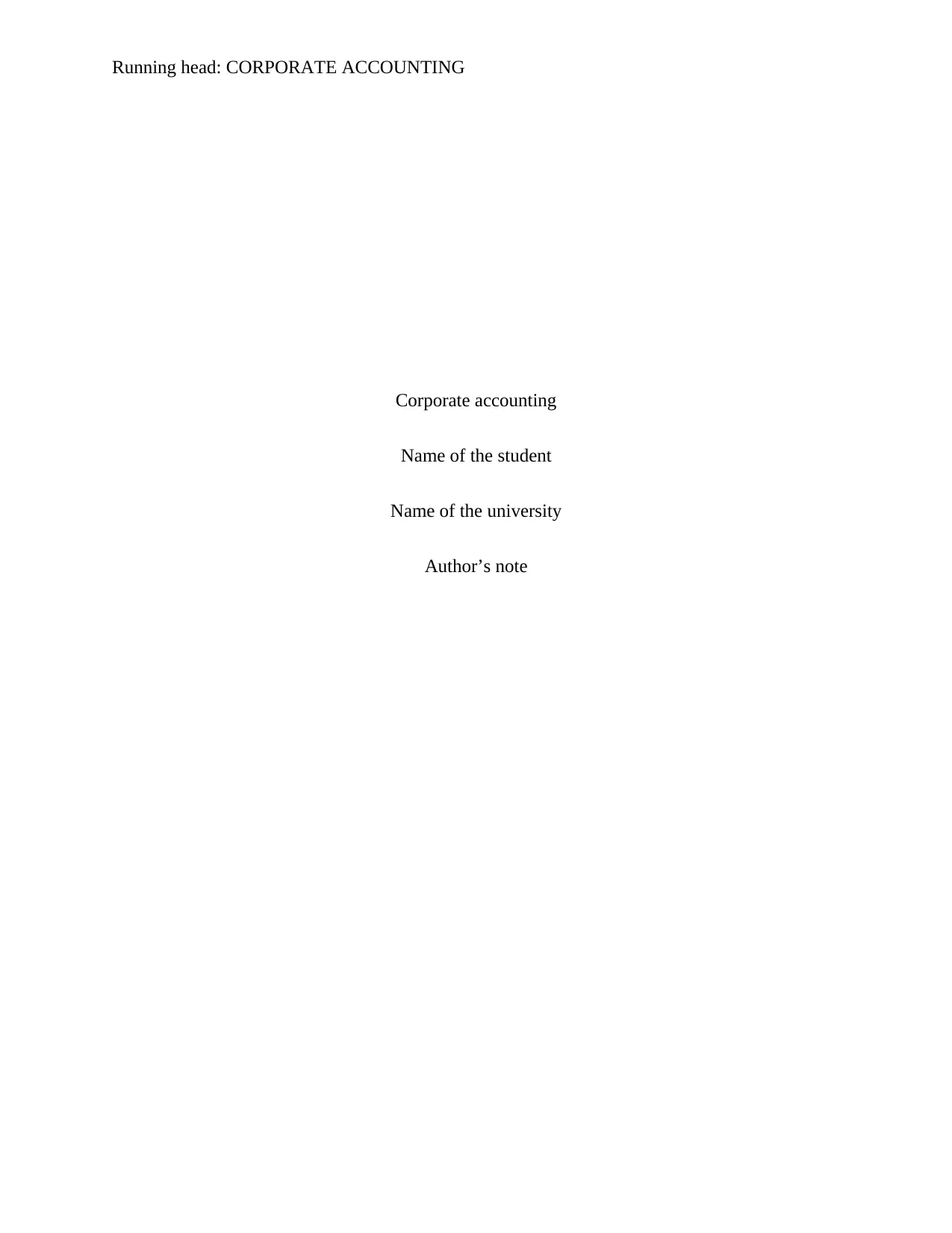
Running head: CORPORATE ACCOUNTING
Corporate accounting
Name of the student
Name of the university
Author’s note
Corporate accounting
Name of the student
Name of the university
Author’s note
Paraphrase This Document
Need a fresh take? Get an instant paraphrase of this document with our AI Paraphraser
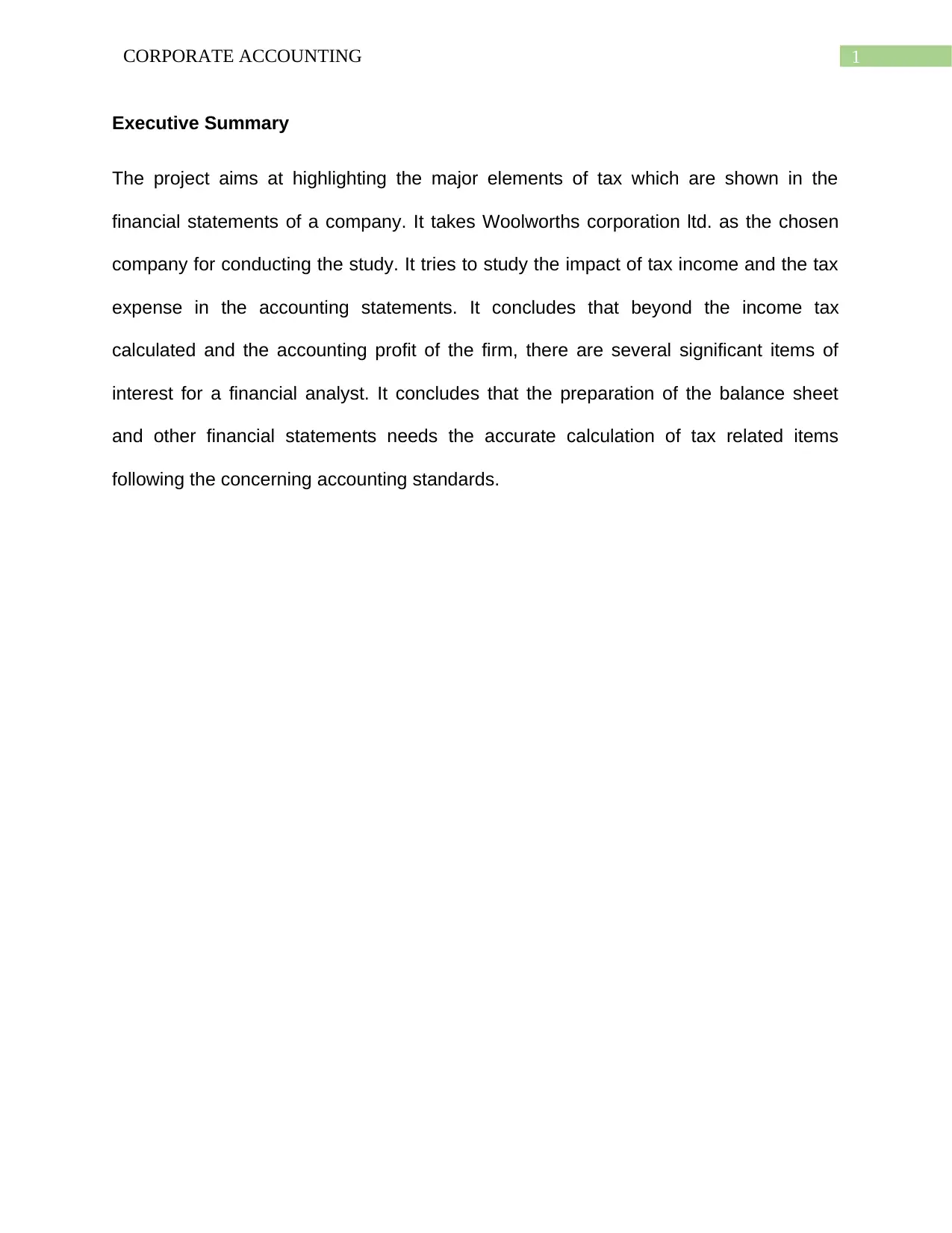
1CORPORATE ACCOUNTING
Executive Summary
The project aims at highlighting the major elements of tax which are shown in the
financial statements of a company. It takes Woolworths corporation ltd. as the chosen
company for conducting the study. It tries to study the impact of tax income and the tax
expense in the accounting statements. It concludes that beyond the income tax
calculated and the accounting profit of the firm, there are several significant items of
interest for a financial analyst. It concludes that the preparation of the balance sheet
and other financial statements needs the accurate calculation of tax related items
following the concerning accounting standards.
Executive Summary
The project aims at highlighting the major elements of tax which are shown in the
financial statements of a company. It takes Woolworths corporation ltd. as the chosen
company for conducting the study. It tries to study the impact of tax income and the tax
expense in the accounting statements. It concludes that beyond the income tax
calculated and the accounting profit of the firm, there are several significant items of
interest for a financial analyst. It concludes that the preparation of the balance sheet
and other financial statements needs the accurate calculation of tax related items
following the concerning accounting standards.
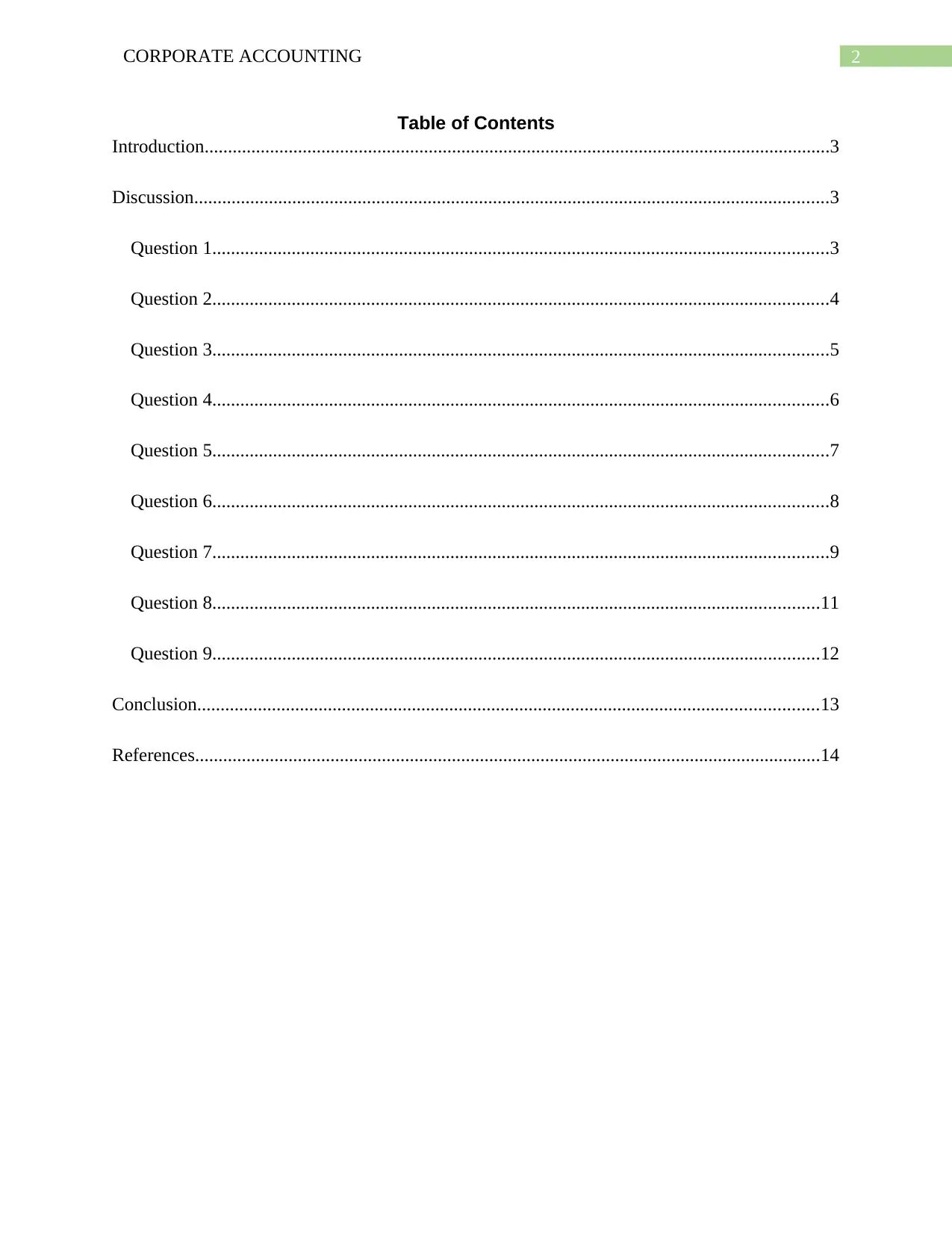
2CORPORATE ACCOUNTING
Table of Contents
Introduction......................................................................................................................................3
Discussion........................................................................................................................................3
Question 1....................................................................................................................................3
Question 2....................................................................................................................................4
Question 3....................................................................................................................................5
Question 4....................................................................................................................................6
Question 5....................................................................................................................................7
Question 6....................................................................................................................................8
Question 7....................................................................................................................................9
Question 8..................................................................................................................................11
Question 9..................................................................................................................................12
Conclusion.....................................................................................................................................13
References......................................................................................................................................14
Table of Contents
Introduction......................................................................................................................................3
Discussion........................................................................................................................................3
Question 1....................................................................................................................................3
Question 2....................................................................................................................................4
Question 3....................................................................................................................................5
Question 4....................................................................................................................................6
Question 5....................................................................................................................................7
Question 6....................................................................................................................................8
Question 7....................................................................................................................................9
Question 8..................................................................................................................................11
Question 9..................................................................................................................................12
Conclusion.....................................................................................................................................13
References......................................................................................................................................14
⊘ This is a preview!⊘
Do you want full access?
Subscribe today to unlock all pages.

Trusted by 1+ million students worldwide
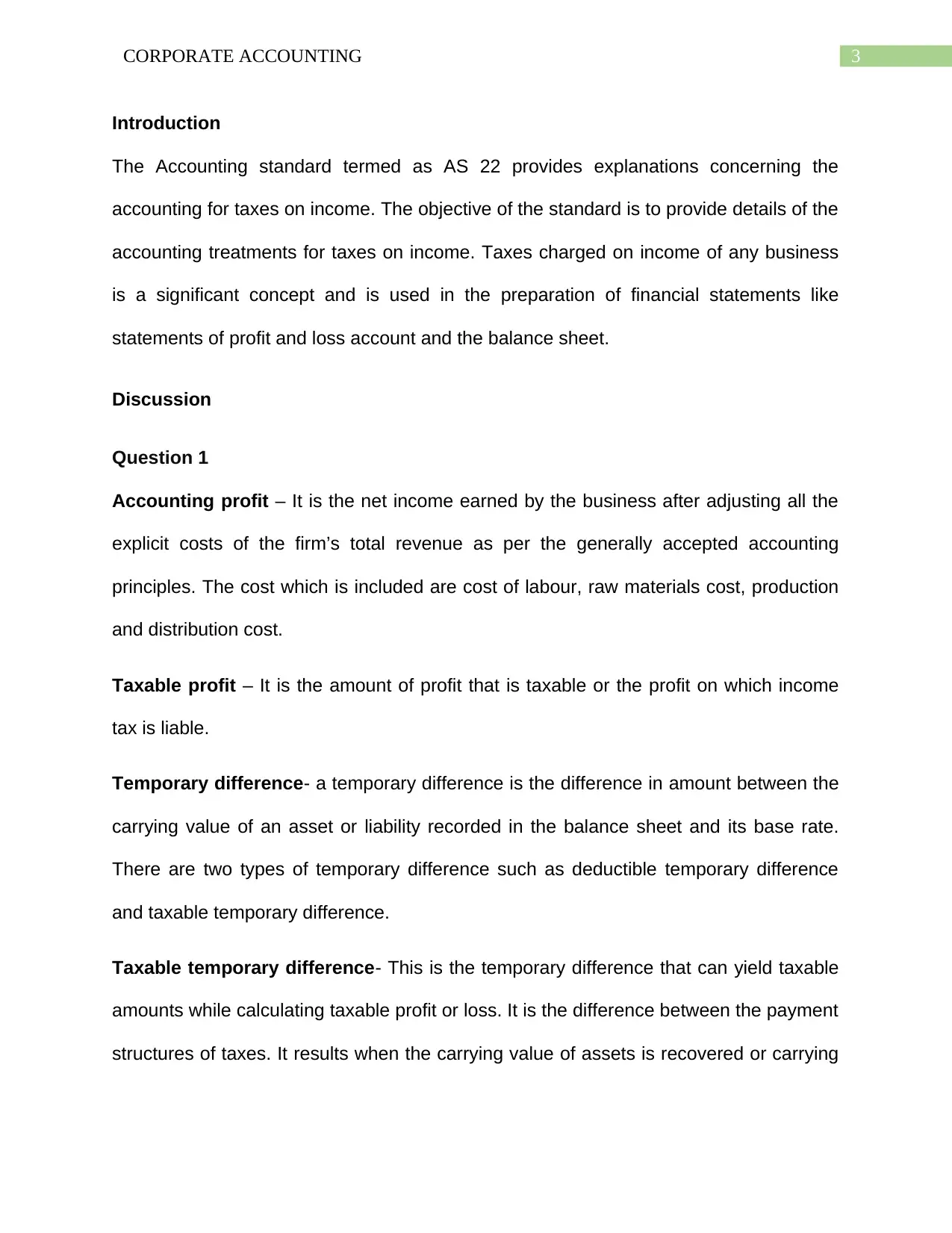
3CORPORATE ACCOUNTING
Introduction
The Accounting standard termed as AS 22 provides explanations concerning the
accounting for taxes on income. The objective of the standard is to provide details of the
accounting treatments for taxes on income. Taxes charged on income of any business
is a significant concept and is used in the preparation of financial statements like
statements of profit and loss account and the balance sheet.
Discussion
Question 1
Accounting profit – It is the net income earned by the business after adjusting all the
explicit costs of the firm’s total revenue as per the generally accepted accounting
principles. The cost which is included are cost of labour, raw materials cost, production
and distribution cost.
Taxable profit – It is the amount of profit that is taxable or the profit on which income
tax is liable.
Temporary difference- a temporary difference is the difference in amount between the
carrying value of an asset or liability recorded in the balance sheet and its base rate.
There are two types of temporary difference such as deductible temporary difference
and taxable temporary difference.
Taxable temporary difference- This is the temporary difference that can yield taxable
amounts while calculating taxable profit or loss. It is the difference between the payment
structures of taxes. It results when the carrying value of assets is recovered or carrying
Introduction
The Accounting standard termed as AS 22 provides explanations concerning the
accounting for taxes on income. The objective of the standard is to provide details of the
accounting treatments for taxes on income. Taxes charged on income of any business
is a significant concept and is used in the preparation of financial statements like
statements of profit and loss account and the balance sheet.
Discussion
Question 1
Accounting profit – It is the net income earned by the business after adjusting all the
explicit costs of the firm’s total revenue as per the generally accepted accounting
principles. The cost which is included are cost of labour, raw materials cost, production
and distribution cost.
Taxable profit – It is the amount of profit that is taxable or the profit on which income
tax is liable.
Temporary difference- a temporary difference is the difference in amount between the
carrying value of an asset or liability recorded in the balance sheet and its base rate.
There are two types of temporary difference such as deductible temporary difference
and taxable temporary difference.
Taxable temporary difference- This is the temporary difference that can yield taxable
amounts while calculating taxable profit or loss. It is the difference between the payment
structures of taxes. It results when the carrying value of assets is recovered or carrying
Paraphrase This Document
Need a fresh take? Get an instant paraphrase of this document with our AI Paraphraser
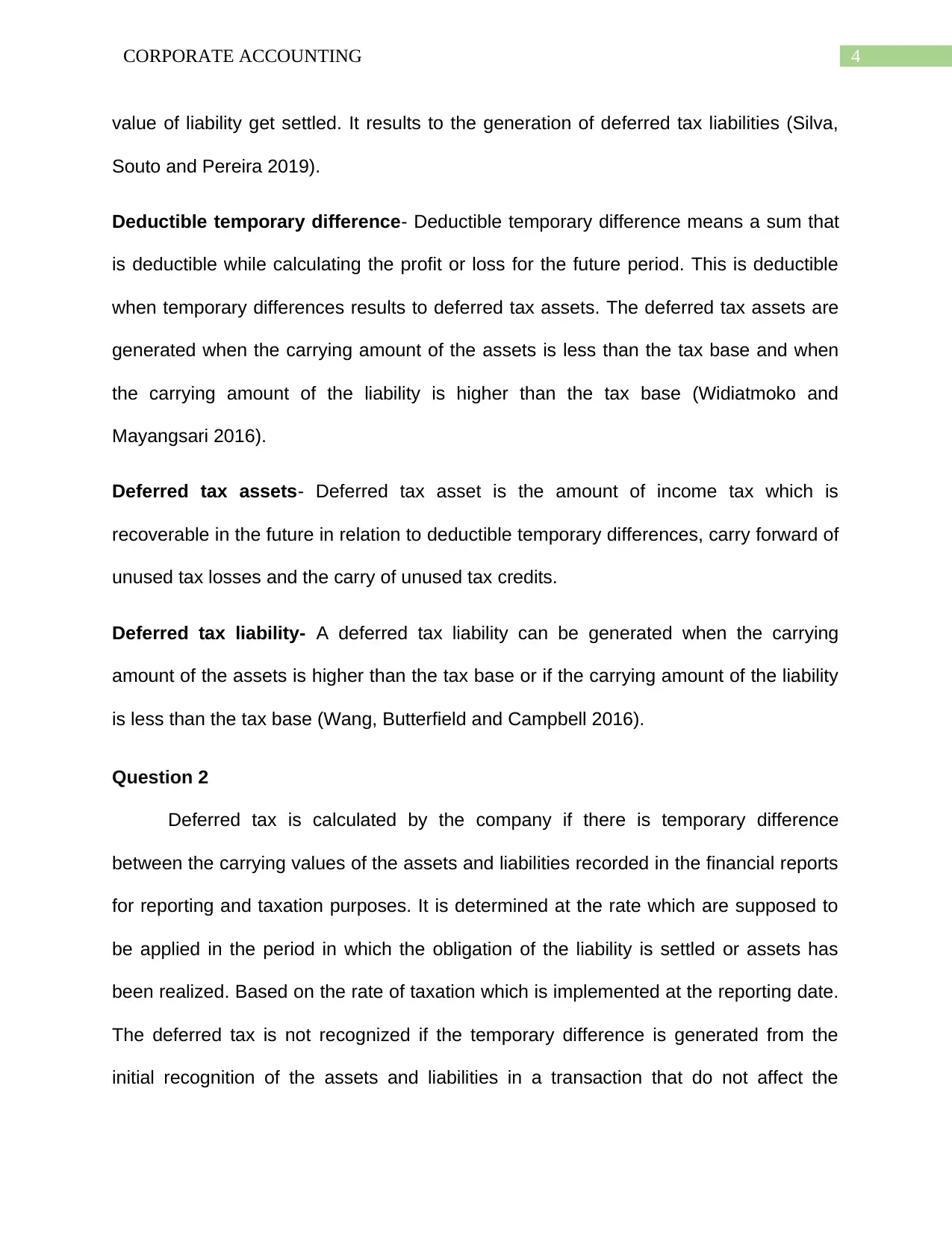
4CORPORATE ACCOUNTING
value of liability get settled. It results to the generation of deferred tax liabilities (Silva,
Souto and Pereira 2019).
Deductible temporary difference- Deductible temporary difference means a sum that
is deductible while calculating the profit or loss for the future period. This is deductible
when temporary differences results to deferred tax assets. The deferred tax assets are
generated when the carrying amount of the assets is less than the tax base and when
the carrying amount of the liability is higher than the tax base (Widiatmoko and
Mayangsari 2016).
Deferred tax assets- Deferred tax asset is the amount of income tax which is
recoverable in the future in relation to deductible temporary differences, carry forward of
unused tax losses and the carry of unused tax credits.
Deferred tax liability- A deferred tax liability can be generated when the carrying
amount of the assets is higher than the tax base or if the carrying amount of the liability
is less than the tax base (Wang, Butterfield and Campbell 2016).
Question 2
Deferred tax is calculated by the company if there is temporary difference
between the carrying values of the assets and liabilities recorded in the financial reports
for reporting and taxation purposes. It is determined at the rate which are supposed to
be applied in the period in which the obligation of the liability is settled or assets has
been realized. Based on the rate of taxation which is implemented at the reporting date.
The deferred tax is not recognized if the temporary difference is generated from the
initial recognition of the assets and liabilities in a transaction that do not affect the
value of liability get settled. It results to the generation of deferred tax liabilities (Silva,
Souto and Pereira 2019).
Deductible temporary difference- Deductible temporary difference means a sum that
is deductible while calculating the profit or loss for the future period. This is deductible
when temporary differences results to deferred tax assets. The deferred tax assets are
generated when the carrying amount of the assets is less than the tax base and when
the carrying amount of the liability is higher than the tax base (Widiatmoko and
Mayangsari 2016).
Deferred tax assets- Deferred tax asset is the amount of income tax which is
recoverable in the future in relation to deductible temporary differences, carry forward of
unused tax losses and the carry of unused tax credits.
Deferred tax liability- A deferred tax liability can be generated when the carrying
amount of the assets is higher than the tax base or if the carrying amount of the liability
is less than the tax base (Wang, Butterfield and Campbell 2016).
Question 2
Deferred tax is calculated by the company if there is temporary difference
between the carrying values of the assets and liabilities recorded in the financial reports
for reporting and taxation purposes. It is determined at the rate which are supposed to
be applied in the period in which the obligation of the liability is settled or assets has
been realized. Based on the rate of taxation which is implemented at the reporting date.
The deferred tax is not recognized if the temporary difference is generated from the
initial recognition of the assets and liabilities in a transaction that do not affect the
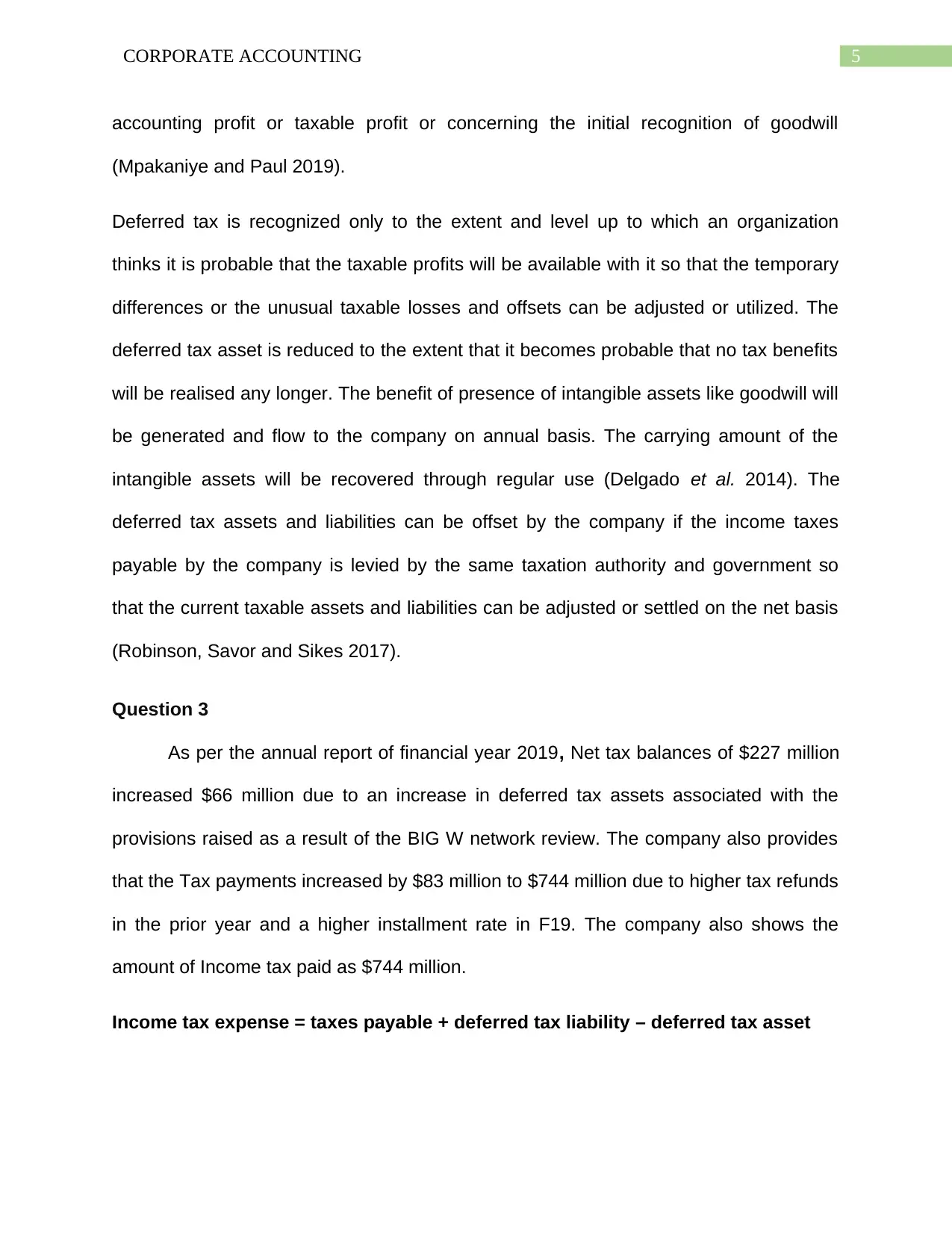
5CORPORATE ACCOUNTING
accounting profit or taxable profit or concerning the initial recognition of goodwill
(Mpakaniye and Paul 2019).
Deferred tax is recognized only to the extent and level up to which an organization
thinks it is probable that the taxable profits will be available with it so that the temporary
differences or the unusual taxable losses and offsets can be adjusted or utilized. The
deferred tax asset is reduced to the extent that it becomes probable that no tax benefits
will be realised any longer. The benefit of presence of intangible assets like goodwill will
be generated and flow to the company on annual basis. The carrying amount of the
intangible assets will be recovered through regular use (Delgado et al. 2014). The
deferred tax assets and liabilities can be offset by the company if the income taxes
payable by the company is levied by the same taxation authority and government so
that the current taxable assets and liabilities can be adjusted or settled on the net basis
(Robinson, Savor and Sikes 2017).
Question 3
As per the annual report of financial year 2019, Net tax balances of $227 million
increased $66 million due to an increase in deferred tax assets associated with the
provisions raised as a result of the BIG W network review. The company also provides
that the Tax payments increased by $83 million to $744 million due to higher tax refunds
in the prior year and a higher installment rate in F19. The company also shows the
amount of Income tax paid as $744 million.
Income tax expense = taxes payable + deferred tax liability – deferred tax asset
accounting profit or taxable profit or concerning the initial recognition of goodwill
(Mpakaniye and Paul 2019).
Deferred tax is recognized only to the extent and level up to which an organization
thinks it is probable that the taxable profits will be available with it so that the temporary
differences or the unusual taxable losses and offsets can be adjusted or utilized. The
deferred tax asset is reduced to the extent that it becomes probable that no tax benefits
will be realised any longer. The benefit of presence of intangible assets like goodwill will
be generated and flow to the company on annual basis. The carrying amount of the
intangible assets will be recovered through regular use (Delgado et al. 2014). The
deferred tax assets and liabilities can be offset by the company if the income taxes
payable by the company is levied by the same taxation authority and government so
that the current taxable assets and liabilities can be adjusted or settled on the net basis
(Robinson, Savor and Sikes 2017).
Question 3
As per the annual report of financial year 2019, Net tax balances of $227 million
increased $66 million due to an increase in deferred tax assets associated with the
provisions raised as a result of the BIG W network review. The company also provides
that the Tax payments increased by $83 million to $744 million due to higher tax refunds
in the prior year and a higher installment rate in F19. The company also shows the
amount of Income tax paid as $744 million.
Income tax expense = taxes payable + deferred tax liability – deferred tax asset
⊘ This is a preview!⊘
Do you want full access?
Subscribe today to unlock all pages.

Trusted by 1+ million students worldwide
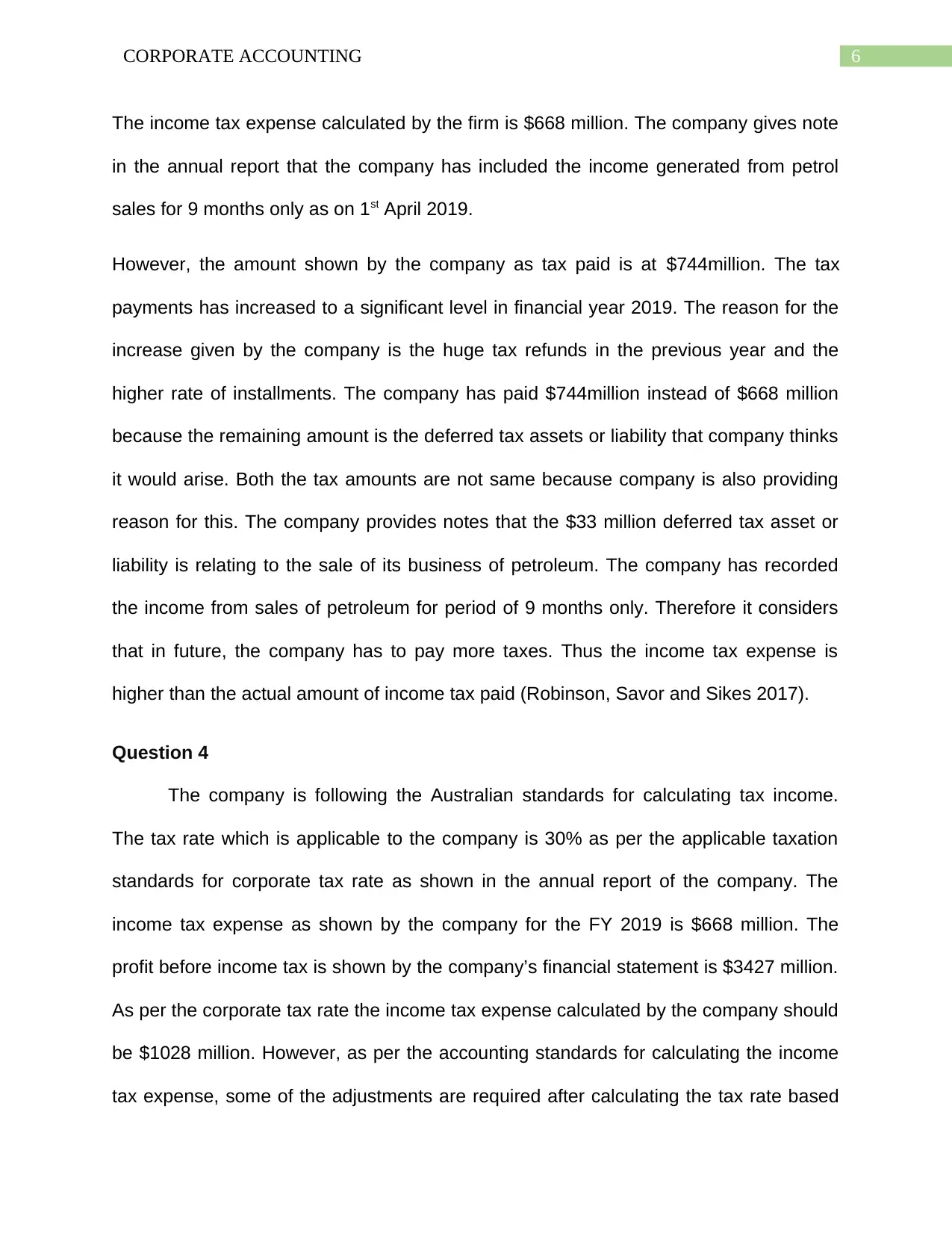
6CORPORATE ACCOUNTING
The income tax expense calculated by the firm is $668 million. The company gives note
in the annual report that the company has included the income generated from petrol
sales for 9 months only as on 1st April 2019.
However, the amount shown by the company as tax paid is at $744million. The tax
payments has increased to a significant level in financial year 2019. The reason for the
increase given by the company is the huge tax refunds in the previous year and the
higher rate of installments. The company has paid $744million instead of $668 million
because the remaining amount is the deferred tax assets or liability that company thinks
it would arise. Both the tax amounts are not same because company is also providing
reason for this. The company provides notes that the $33 million deferred tax asset or
liability is relating to the sale of its business of petroleum. The company has recorded
the income from sales of petroleum for period of 9 months only. Therefore it considers
that in future, the company has to pay more taxes. Thus the income tax expense is
higher than the actual amount of income tax paid (Robinson, Savor and Sikes 2017).
Question 4
The company is following the Australian standards for calculating tax income.
The tax rate which is applicable to the company is 30% as per the applicable taxation
standards for corporate tax rate as shown in the annual report of the company. The
income tax expense as shown by the company for the FY 2019 is $668 million. The
profit before income tax is shown by the company’s financial statement is $3427 million.
As per the corporate tax rate the income tax expense calculated by the company should
be $1028 million. However, as per the accounting standards for calculating the income
tax expense, some of the adjustments are required after calculating the tax rate based
The income tax expense calculated by the firm is $668 million. The company gives note
in the annual report that the company has included the income generated from petrol
sales for 9 months only as on 1st April 2019.
However, the amount shown by the company as tax paid is at $744million. The tax
payments has increased to a significant level in financial year 2019. The reason for the
increase given by the company is the huge tax refunds in the previous year and the
higher rate of installments. The company has paid $744million instead of $668 million
because the remaining amount is the deferred tax assets or liability that company thinks
it would arise. Both the tax amounts are not same because company is also providing
reason for this. The company provides notes that the $33 million deferred tax asset or
liability is relating to the sale of its business of petroleum. The company has recorded
the income from sales of petroleum for period of 9 months only. Therefore it considers
that in future, the company has to pay more taxes. Thus the income tax expense is
higher than the actual amount of income tax paid (Robinson, Savor and Sikes 2017).
Question 4
The company is following the Australian standards for calculating tax income.
The tax rate which is applicable to the company is 30% as per the applicable taxation
standards for corporate tax rate as shown in the annual report of the company. The
income tax expense as shown by the company for the FY 2019 is $668 million. The
profit before income tax is shown by the company’s financial statement is $3427 million.
As per the corporate tax rate the income tax expense calculated by the company should
be $1028 million. However, as per the accounting standards for calculating the income
tax expense, some of the adjustments are required after calculating the tax rate based
Paraphrase This Document
Need a fresh take? Get an instant paraphrase of this document with our AI Paraphraser
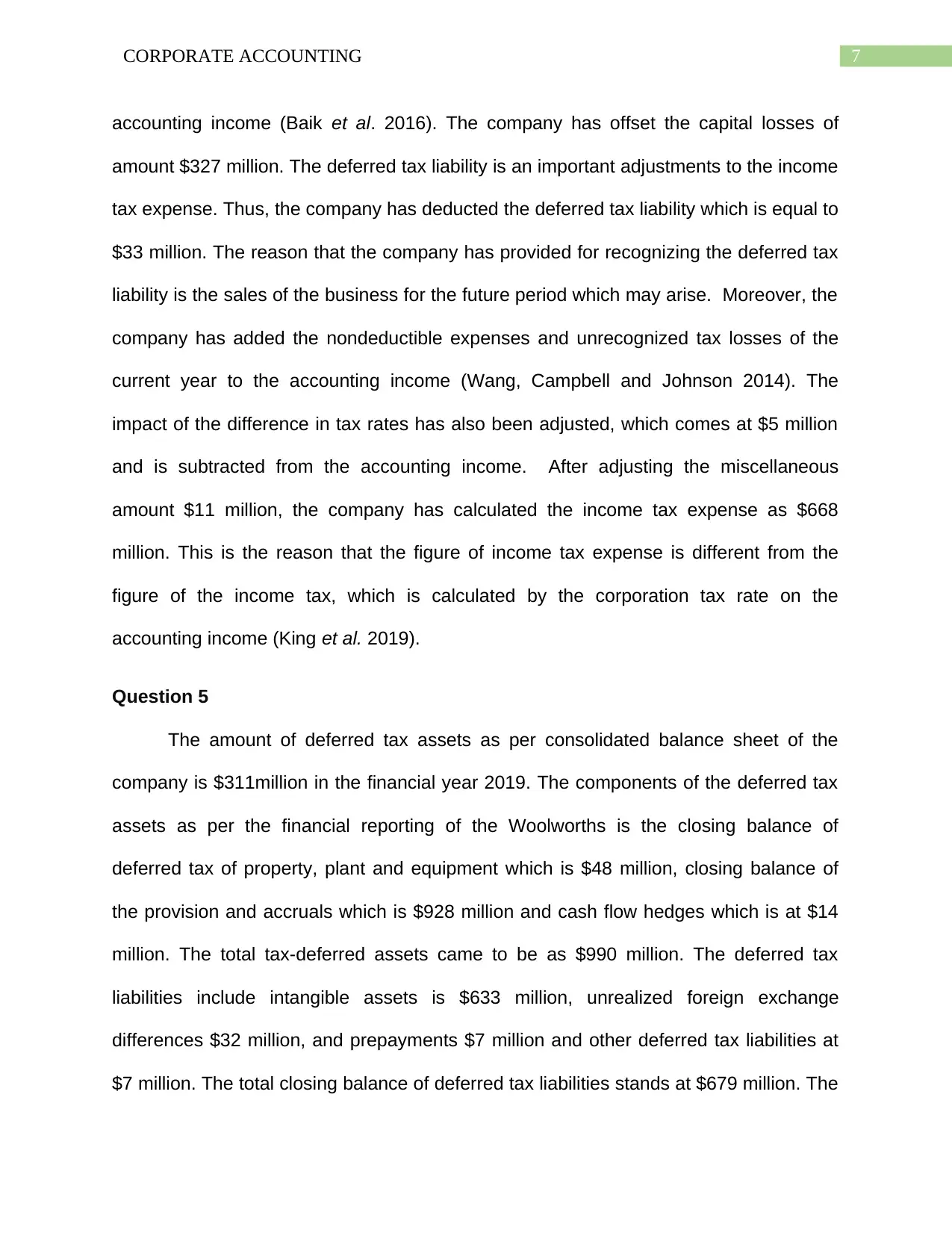
7CORPORATE ACCOUNTING
accounting income (Baik et al. 2016). The company has offset the capital losses of
amount $327 million. The deferred tax liability is an important adjustments to the income
tax expense. Thus, the company has deducted the deferred tax liability which is equal to
$33 million. The reason that the company has provided for recognizing the deferred tax
liability is the sales of the business for the future period which may arise. Moreover, the
company has added the nondeductible expenses and unrecognized tax losses of the
current year to the accounting income (Wang, Campbell and Johnson 2014). The
impact of the difference in tax rates has also been adjusted, which comes at $5 million
and is subtracted from the accounting income. After adjusting the miscellaneous
amount $11 million, the company has calculated the income tax expense as $668
million. This is the reason that the figure of income tax expense is different from the
figure of the income tax, which is calculated by the corporation tax rate on the
accounting income (King et al. 2019).
Question 5
The amount of deferred tax assets as per consolidated balance sheet of the
company is $311million in the financial year 2019. The components of the deferred tax
assets as per the financial reporting of the Woolworths is the closing balance of
deferred tax of property, plant and equipment which is $48 million, closing balance of
the provision and accruals which is $928 million and cash flow hedges which is at $14
million. The total tax-deferred assets came to be as $990 million. The deferred tax
liabilities include intangible assets is $633 million, unrealized foreign exchange
differences $32 million, and prepayments $7 million and other deferred tax liabilities at
$7 million. The total closing balance of deferred tax liabilities stands at $679 million. The
accounting income (Baik et al. 2016). The company has offset the capital losses of
amount $327 million. The deferred tax liability is an important adjustments to the income
tax expense. Thus, the company has deducted the deferred tax liability which is equal to
$33 million. The reason that the company has provided for recognizing the deferred tax
liability is the sales of the business for the future period which may arise. Moreover, the
company has added the nondeductible expenses and unrecognized tax losses of the
current year to the accounting income (Wang, Campbell and Johnson 2014). The
impact of the difference in tax rates has also been adjusted, which comes at $5 million
and is subtracted from the accounting income. After adjusting the miscellaneous
amount $11 million, the company has calculated the income tax expense as $668
million. This is the reason that the figure of income tax expense is different from the
figure of the income tax, which is calculated by the corporation tax rate on the
accounting income (King et al. 2019).
Question 5
The amount of deferred tax assets as per consolidated balance sheet of the
company is $311million in the financial year 2019. The components of the deferred tax
assets as per the financial reporting of the Woolworths is the closing balance of
deferred tax of property, plant and equipment which is $48 million, closing balance of
the provision and accruals which is $928 million and cash flow hedges which is at $14
million. The total tax-deferred assets came to be as $990 million. The deferred tax
liabilities include intangible assets is $633 million, unrealized foreign exchange
differences $32 million, and prepayments $7 million and other deferred tax liabilities at
$7 million. The total closing balance of deferred tax liabilities stands at $679 million. The
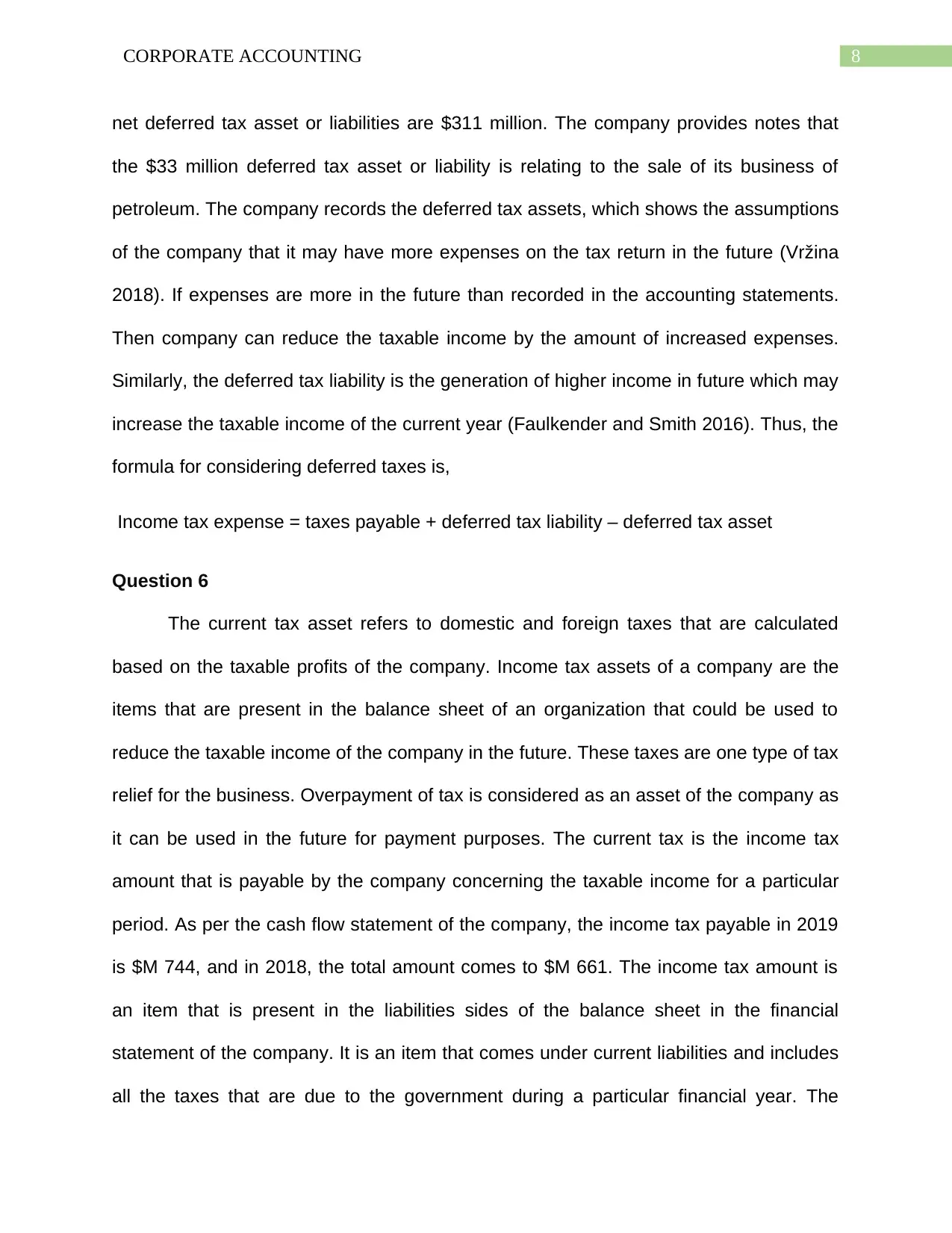
8CORPORATE ACCOUNTING
net deferred tax asset or liabilities are $311 million. The company provides notes that
the $33 million deferred tax asset or liability is relating to the sale of its business of
petroleum. The company records the deferred tax assets, which shows the assumptions
of the company that it may have more expenses on the tax return in the future (Vržina
2018). If expenses are more in the future than recorded in the accounting statements.
Then company can reduce the taxable income by the amount of increased expenses.
Similarly, the deferred tax liability is the generation of higher income in future which may
increase the taxable income of the current year (Faulkender and Smith 2016). Thus, the
formula for considering deferred taxes is,
Income tax expense = taxes payable + deferred tax liability – deferred tax asset
Question 6
The current tax asset refers to domestic and foreign taxes that are calculated
based on the taxable profits of the company. Income tax assets of a company are the
items that are present in the balance sheet of an organization that could be used to
reduce the taxable income of the company in the future. These taxes are one type of tax
relief for the business. Overpayment of tax is considered as an asset of the company as
it can be used in the future for payment purposes. The current tax is the income tax
amount that is payable by the company concerning the taxable income for a particular
period. As per the cash flow statement of the company, the income tax payable in 2019
is $M 744, and in 2018, the total amount comes to $M 661. The income tax amount is
an item that is present in the liabilities sides of the balance sheet in the financial
statement of the company. It is an item that comes under current liabilities and includes
all the taxes that are due to the government during a particular financial year. The
net deferred tax asset or liabilities are $311 million. The company provides notes that
the $33 million deferred tax asset or liability is relating to the sale of its business of
petroleum. The company records the deferred tax assets, which shows the assumptions
of the company that it may have more expenses on the tax return in the future (Vržina
2018). If expenses are more in the future than recorded in the accounting statements.
Then company can reduce the taxable income by the amount of increased expenses.
Similarly, the deferred tax liability is the generation of higher income in future which may
increase the taxable income of the current year (Faulkender and Smith 2016). Thus, the
formula for considering deferred taxes is,
Income tax expense = taxes payable + deferred tax liability – deferred tax asset
Question 6
The current tax asset refers to domestic and foreign taxes that are calculated
based on the taxable profits of the company. Income tax assets of a company are the
items that are present in the balance sheet of an organization that could be used to
reduce the taxable income of the company in the future. These taxes are one type of tax
relief for the business. Overpayment of tax is considered as an asset of the company as
it can be used in the future for payment purposes. The current tax is the income tax
amount that is payable by the company concerning the taxable income for a particular
period. As per the cash flow statement of the company, the income tax payable in 2019
is $M 744, and in 2018, the total amount comes to $M 661. The income tax amount is
an item that is present in the liabilities sides of the balance sheet in the financial
statement of the company. It is an item that comes under current liabilities and includes
all the taxes that are due to the government during a particular financial year. The
⊘ This is a preview!⊘
Do you want full access?
Subscribe today to unlock all pages.

Trusted by 1+ million students worldwide
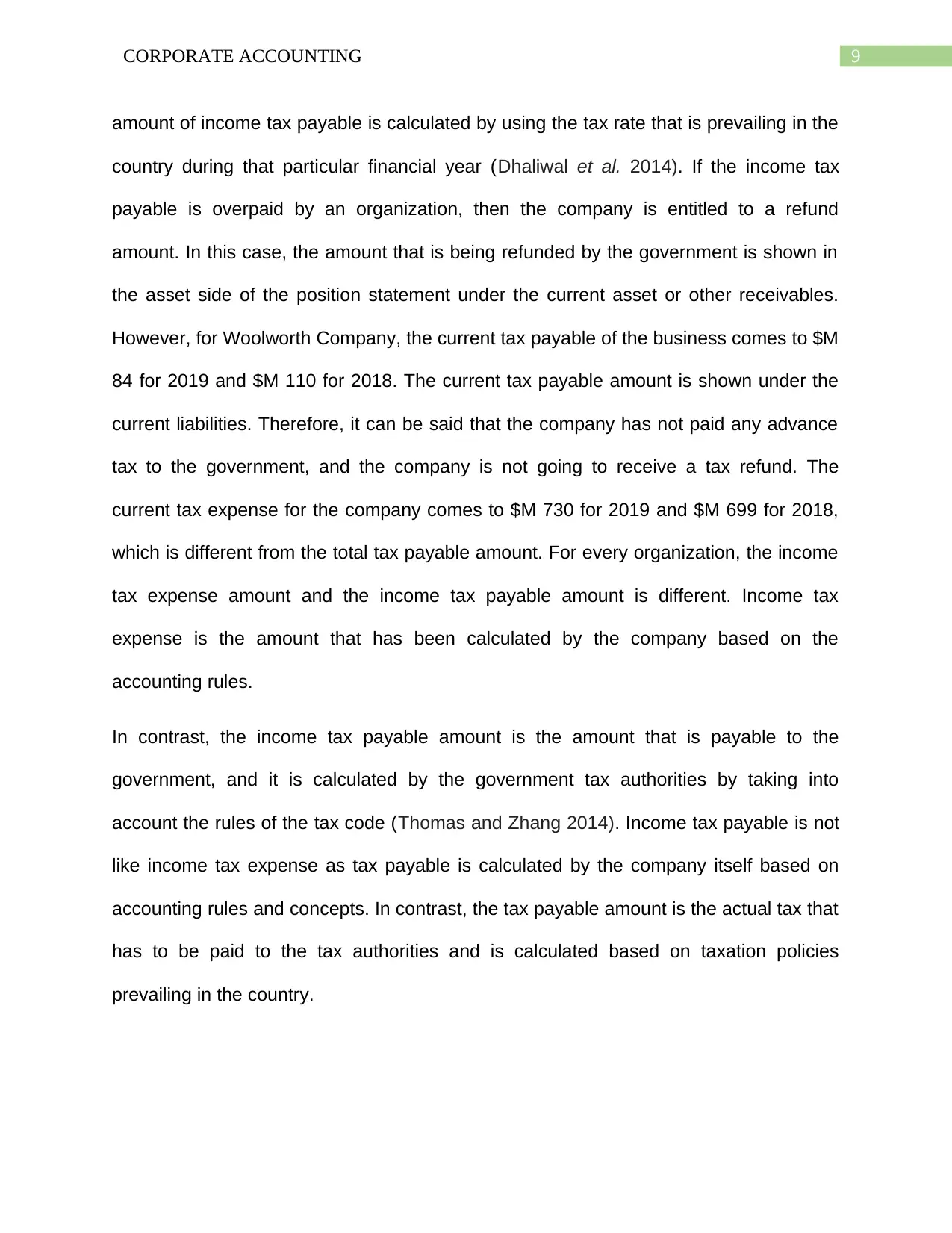
9CORPORATE ACCOUNTING
amount of income tax payable is calculated by using the tax rate that is prevailing in the
country during that particular financial year (Dhaliwal et al. 2014). If the income tax
payable is overpaid by an organization, then the company is entitled to a refund
amount. In this case, the amount that is being refunded by the government is shown in
the asset side of the position statement under the current asset or other receivables.
However, for Woolworth Company, the current tax payable of the business comes to $M
84 for 2019 and $M 110 for 2018. The current tax payable amount is shown under the
current liabilities. Therefore, it can be said that the company has not paid any advance
tax to the government, and the company is not going to receive a tax refund. The
current tax expense for the company comes to $M 730 for 2019 and $M 699 for 2018,
which is different from the total tax payable amount. For every organization, the income
tax expense amount and the income tax payable amount is different. Income tax
expense is the amount that has been calculated by the company based on the
accounting rules.
In contrast, the income tax payable amount is the amount that is payable to the
government, and it is calculated by the government tax authorities by taking into
account the rules of the tax code (Thomas and Zhang 2014). Income tax payable is not
like income tax expense as tax payable is calculated by the company itself based on
accounting rules and concepts. In contrast, the tax payable amount is the actual tax that
has to be paid to the tax authorities and is calculated based on taxation policies
prevailing in the country.
amount of income tax payable is calculated by using the tax rate that is prevailing in the
country during that particular financial year (Dhaliwal et al. 2014). If the income tax
payable is overpaid by an organization, then the company is entitled to a refund
amount. In this case, the amount that is being refunded by the government is shown in
the asset side of the position statement under the current asset or other receivables.
However, for Woolworth Company, the current tax payable of the business comes to $M
84 for 2019 and $M 110 for 2018. The current tax payable amount is shown under the
current liabilities. Therefore, it can be said that the company has not paid any advance
tax to the government, and the company is not going to receive a tax refund. The
current tax expense for the company comes to $M 730 for 2019 and $M 699 for 2018,
which is different from the total tax payable amount. For every organization, the income
tax expense amount and the income tax payable amount is different. Income tax
expense is the amount that has been calculated by the company based on the
accounting rules.
In contrast, the income tax payable amount is the amount that is payable to the
government, and it is calculated by the government tax authorities by taking into
account the rules of the tax code (Thomas and Zhang 2014). Income tax payable is not
like income tax expense as tax payable is calculated by the company itself based on
accounting rules and concepts. In contrast, the tax payable amount is the actual tax that
has to be paid to the tax authorities and is calculated based on taxation policies
prevailing in the country.
Paraphrase This Document
Need a fresh take? Get an instant paraphrase of this document with our AI Paraphraser
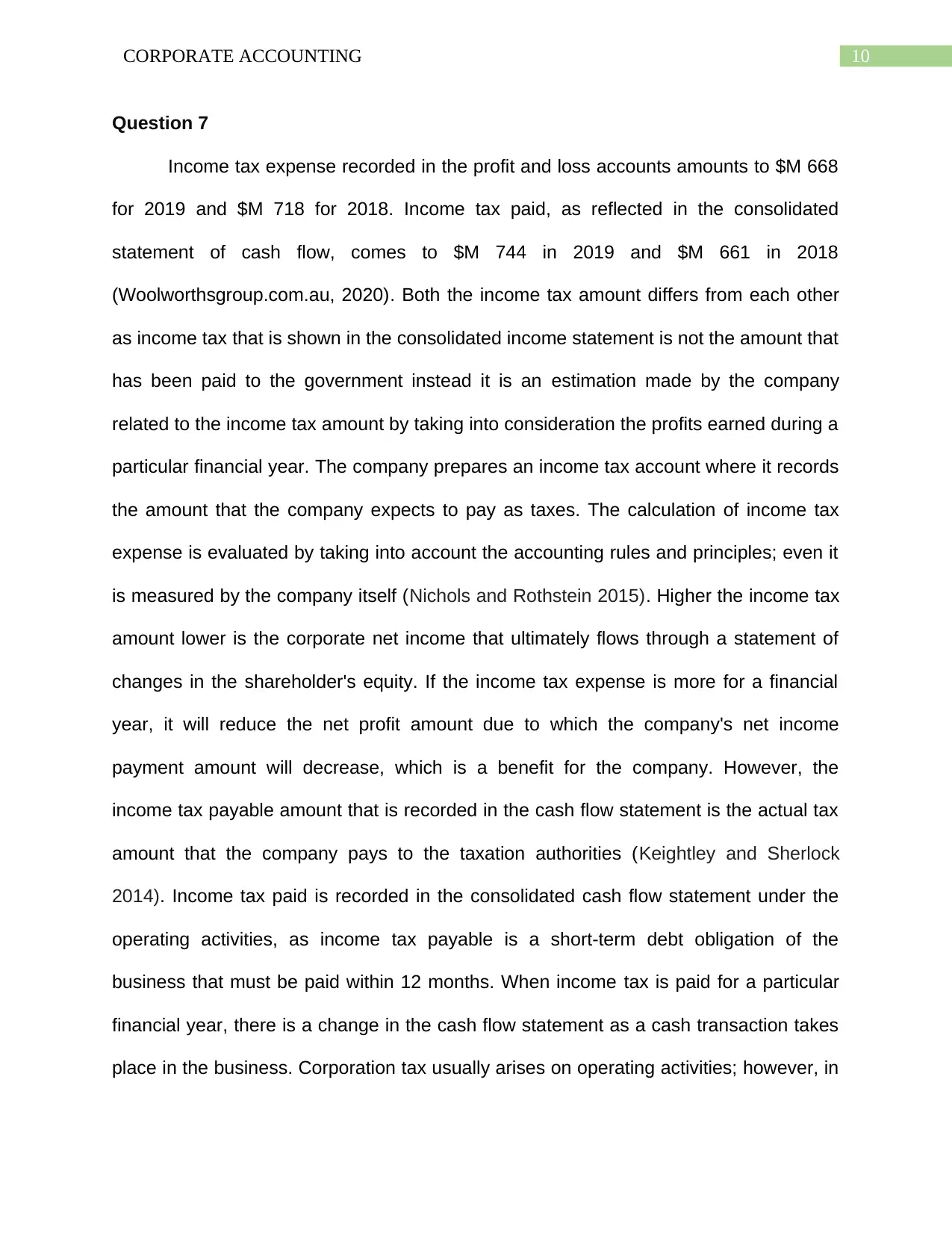
10CORPORATE ACCOUNTING
Question 7
Income tax expense recorded in the profit and loss accounts amounts to $M 668
for 2019 and $M 718 for 2018. Income tax paid, as reflected in the consolidated
statement of cash flow, comes to $M 744 in 2019 and $M 661 in 2018
(Woolworthsgroup.com.au, 2020). Both the income tax amount differs from each other
as income tax that is shown in the consolidated income statement is not the amount that
has been paid to the government instead it is an estimation made by the company
related to the income tax amount by taking into consideration the profits earned during a
particular financial year. The company prepares an income tax account where it records
the amount that the company expects to pay as taxes. The calculation of income tax
expense is evaluated by taking into account the accounting rules and principles; even it
is measured by the company itself (Nichols and Rothstein 2015). Higher the income tax
amount lower is the corporate net income that ultimately flows through a statement of
changes in the shareholder's equity. If the income tax expense is more for a financial
year, it will reduce the net profit amount due to which the company's net income
payment amount will decrease, which is a benefit for the company. However, the
income tax payable amount that is recorded in the cash flow statement is the actual tax
amount that the company pays to the taxation authorities (Keightley and Sherlock
2014). Income tax paid is recorded in the consolidated cash flow statement under the
operating activities, as income tax payable is a short-term debt obligation of the
business that must be paid within 12 months. When income tax is paid for a particular
financial year, there is a change in the cash flow statement as a cash transaction takes
place in the business. Corporation tax usually arises on operating activities; however, in
Question 7
Income tax expense recorded in the profit and loss accounts amounts to $M 668
for 2019 and $M 718 for 2018. Income tax paid, as reflected in the consolidated
statement of cash flow, comes to $M 744 in 2019 and $M 661 in 2018
(Woolworthsgroup.com.au, 2020). Both the income tax amount differs from each other
as income tax that is shown in the consolidated income statement is not the amount that
has been paid to the government instead it is an estimation made by the company
related to the income tax amount by taking into consideration the profits earned during a
particular financial year. The company prepares an income tax account where it records
the amount that the company expects to pay as taxes. The calculation of income tax
expense is evaluated by taking into account the accounting rules and principles; even it
is measured by the company itself (Nichols and Rothstein 2015). Higher the income tax
amount lower is the corporate net income that ultimately flows through a statement of
changes in the shareholder's equity. If the income tax expense is more for a financial
year, it will reduce the net profit amount due to which the company's net income
payment amount will decrease, which is a benefit for the company. However, the
income tax payable amount that is recorded in the cash flow statement is the actual tax
amount that the company pays to the taxation authorities (Keightley and Sherlock
2014). Income tax paid is recorded in the consolidated cash flow statement under the
operating activities, as income tax payable is a short-term debt obligation of the
business that must be paid within 12 months. When income tax is paid for a particular
financial year, there is a change in the cash flow statement as a cash transaction takes
place in the business. Corporation tax usually arises on operating activities; however, in
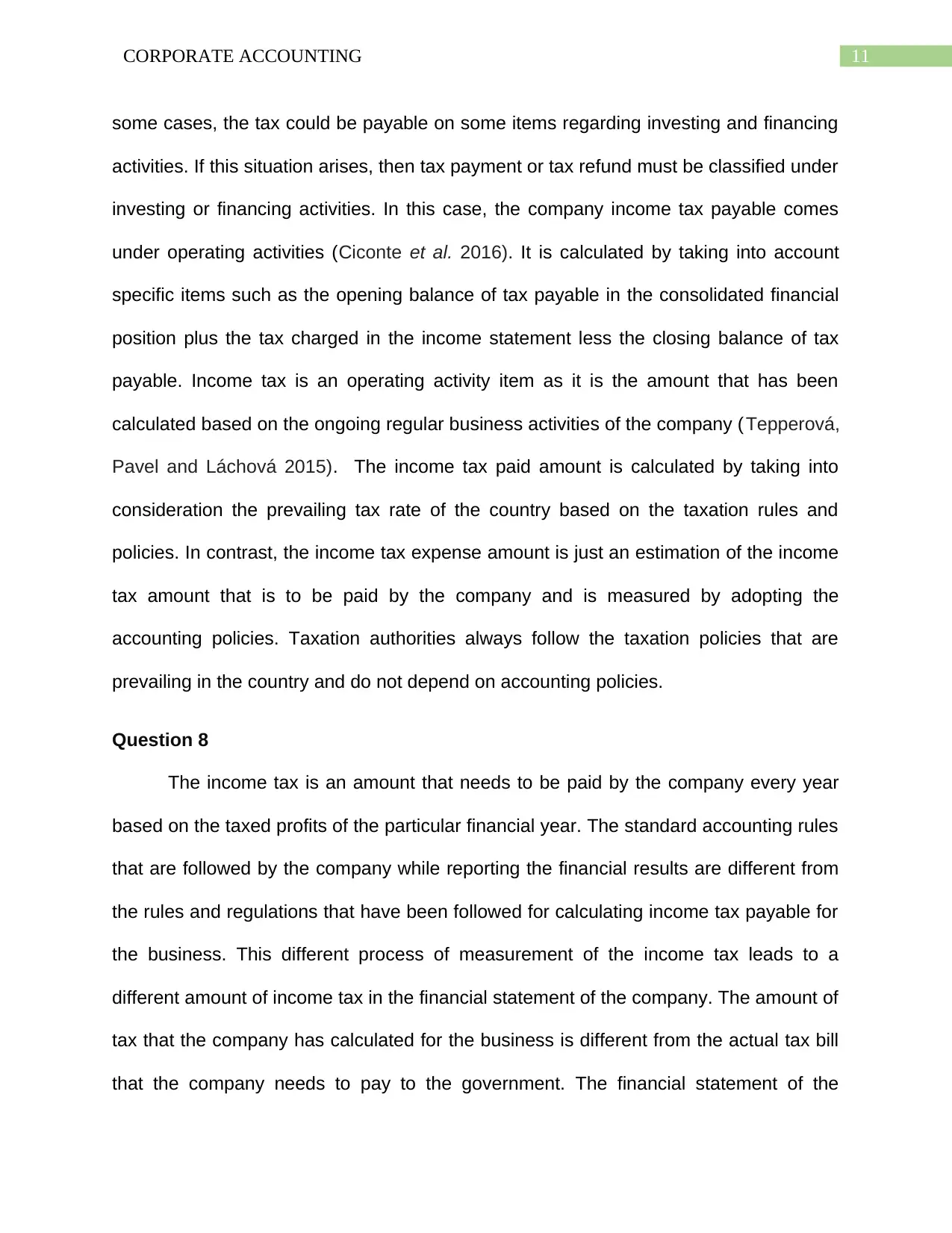
11CORPORATE ACCOUNTING
some cases, the tax could be payable on some items regarding investing and financing
activities. If this situation arises, then tax payment or tax refund must be classified under
investing or financing activities. In this case, the company income tax payable comes
under operating activities (Ciconte et al. 2016). It is calculated by taking into account
specific items such as the opening balance of tax payable in the consolidated financial
position plus the tax charged in the income statement less the closing balance of tax
payable. Income tax is an operating activity item as it is the amount that has been
calculated based on the ongoing regular business activities of the company (Tepperová,
Pavel and Láchová 2015). The income tax paid amount is calculated by taking into
consideration the prevailing tax rate of the country based on the taxation rules and
policies. In contrast, the income tax expense amount is just an estimation of the income
tax amount that is to be paid by the company and is measured by adopting the
accounting policies. Taxation authorities always follow the taxation policies that are
prevailing in the country and do not depend on accounting policies.
Question 8
The income tax is an amount that needs to be paid by the company every year
based on the taxed profits of the particular financial year. The standard accounting rules
that are followed by the company while reporting the financial results are different from
the rules and regulations that have been followed for calculating income tax payable for
the business. This different process of measurement of the income tax leads to a
different amount of income tax in the financial statement of the company. The amount of
tax that the company has calculated for the business is different from the actual tax bill
that the company needs to pay to the government. The financial statement of the
some cases, the tax could be payable on some items regarding investing and financing
activities. If this situation arises, then tax payment or tax refund must be classified under
investing or financing activities. In this case, the company income tax payable comes
under operating activities (Ciconte et al. 2016). It is calculated by taking into account
specific items such as the opening balance of tax payable in the consolidated financial
position plus the tax charged in the income statement less the closing balance of tax
payable. Income tax is an operating activity item as it is the amount that has been
calculated based on the ongoing regular business activities of the company (Tepperová,
Pavel and Láchová 2015). The income tax paid amount is calculated by taking into
consideration the prevailing tax rate of the country based on the taxation rules and
policies. In contrast, the income tax expense amount is just an estimation of the income
tax amount that is to be paid by the company and is measured by adopting the
accounting policies. Taxation authorities always follow the taxation policies that are
prevailing in the country and do not depend on accounting policies.
Question 8
The income tax is an amount that needs to be paid by the company every year
based on the taxed profits of the particular financial year. The standard accounting rules
that are followed by the company while reporting the financial results are different from
the rules and regulations that have been followed for calculating income tax payable for
the business. This different process of measurement of the income tax leads to a
different amount of income tax in the financial statement of the company. The amount of
tax that the company has calculated for the business is different from the actual tax bill
that the company needs to pay to the government. The financial statement of the
⊘ This is a preview!⊘
Do you want full access?
Subscribe today to unlock all pages.

Trusted by 1+ million students worldwide
1 out of 18
Related Documents
Your All-in-One AI-Powered Toolkit for Academic Success.
+13062052269
info@desklib.com
Available 24*7 on WhatsApp / Email
![[object Object]](/_next/static/media/star-bottom.7253800d.svg)
Unlock your academic potential
Copyright © 2020–2025 A2Z Services. All Rights Reserved. Developed and managed by ZUCOL.





